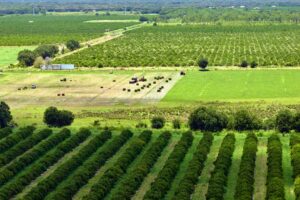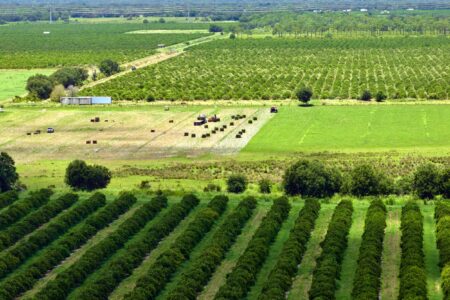In the mid 1960s, competition among machinery manufacturers for farmers’ dollars was red hot. The Big Seven of main-line equipment builders that included Allis-Chalmers, International Harvester Company (IHC), J.I. Case, John Deere, Massey-Ferguson, Minneapolis-Moline, and Oliver were at war over a dwindling number of farmers who wanted more, more, and more — more power, more features, and more convenience.
Short-Lived Series
Meredith Operation Corp., Wisconsin Historical Society
It was into this environment that IHC launched their 56 Series of tractors as a lure to attract buyers to their dealers’ lots. Loaded with features and long on power, these tractors provided advances such as the hydraulic hydrostatic transmission and tailor-made cabs.
The 56 Series were stepping-stone models, a short-lived group of machines built to keep IHC competitive. The tractors would act as a bulwark against John Deere and secondary competitors stealing IHC market share and hope- fully attract new buyers to Big Red.
For Brooks McCormick, the soon-to-be appointed CEO of IHC, the 56 Series also represented the first steps toward his vision of a World Tractor. That effort sought to consolidate IHC’s multiple tractor platforms into a unified series to help streamline manufacturing and create a system of universal parts.
Disjointed Introduction
Meredith Operations Corp., Wisconsin Historical Society
The 56 series did not occur in one introduction as was standard practice for tractor lines at this time. Instead, the series first appeared as the Model 656 introduced in 1965. The previous “06” series that included the models 706, 806, and 1206 continued in production until 1967. Other 56 Series tractors were announced two years later with two additions coming in 1969.
Reflecting McCormick’s vision of the World Tractor, the Model 656 cast a wide net of possibilities for buyers. The tractor, which was sold first under the Farmall name and later badged as an International tractor, was offered in utility, industrial, row-crop (narrow front), western (Wheatland version but with adjustable axles), and High-Clear (with 37 inches of frame clearance) variations. Thus the model was positioned to serve a broader base of agriculture both in North America and Europe.
The 56 Series was also option rich. These offerings included:
• Three engine platforms, including a 4.3-liter, 6-cylinder gas and liquid petroleum (LP) gas power plant (the IHC engine Model C-263), and a 4.6 liter, 6-cylinder diesel platform (IHC engine model D-282).
• Three different transmissions, including a standard 5-speed sliding gear model; 10-speed, 2-range powershift (using a torque amplifier) model; and International’s innovative hydrostatic transmission (which wouldn’t be offered until 1967).
• Even the Model 656’s PTO was optioned out with an upgraded “power-shift PTO” that provided 3 gallons per minute additional flow to operate the PTO’s hydraulic clutch. With all these options and a solid design base, the 656 quickly became the point-of-the-spear aimed at penetrating the marketplace for IHC.
Additional Models Hit in 1967
Two years after the introduction of the Model 656, IHC unveiled the majority of the 56 Series.
• Model 756 was offered under the Farmall and International badges. Originally sold for $8,300, the 756 was powered by either an IHC Model C-291 gas engine or Model D-310 diesel paired up with a 16-speed, 2-range power shift transmission (using a torque amplifier). Other options included a front-wheel assist drive.
• Model 856 was sold under the Farmall and International names with either an IHC Model C-301 gas or LP gas engine, or an International Model D-407 diesel that could be turbocharged.
• Model 1256 was sold in Farmall or International versions and ran with an International engine Model DT407 diesel that turned out 116 PTO hp. To accommodate the Model 1256’s increased torque loads, engineers dropped the old key-and-groove system for attaching rear-drive wheel hubs to the axles with a new wedge-lock system that was more effective while being easier to adjust. Other enhancements to the 1256 included increased oil-cooler capacity, a new turbocharger, and spin-on fuel filters.
Later Additions
Meredith Operations Corp., Wisconsin Historical Society
The 56 Series line was not completely set in 1969. IHC swapped out the Model 1256 with the 130-PTO-hp Model 1456, but production continued until 1971. And the company didn’t ignore the rapidly expanding 4WD market regarding the 56 Series. Building on the design of its first 4WD, the Model 4100, the company introduced the Model 4156 in 1969. This was basically a Model 4100 — using that model’s 7-liter, 6-cylinder diesel, transmission, and cab. But the Model 4156 did offer a new independent PTO. Produced for two years, only 240 Model 4156s were made.
Production of the 56 series ended in 1971 when the Model 1456 was pulled from the market. Besides introducing agriculture to the hydrostatic transmission, the 56 Series established two new creature comfort standards. The first was the industry’s first roll-over protection (ROPS) factory-installed canopy.
The second advance was the creation of a cab designed specifically to fit 56 Models. Built for IHC by A.O. Smith Corporation, these cabs offered air conditioning, defrosting, tinted-glass side and rear windows, windshield wipers, turn signals, and storage for a toolbox or lunch box.


:max_bytes(150000):strip_icc()/Lee-Lubbers-Wheat-August-2024-South-DakotaIMG_7952-79244c166fac424baa84dccc18be6e32.jpeg)

:max_bytes(150000):strip_icc()/fish-habitat-and-jetty-construction-2048x1536-3f12a1341a894afdb0a343e5db33b641.jpg)


:max_bytes(150000):strip_icc()/IHCInternational756HighClear-98610707022b461d9a2e85e3201f9789.jpg)



:max_bytes(150000):strip_icc()/101485674_corn-5d814390db764fcdaa3d3c1e82604454.jpg)